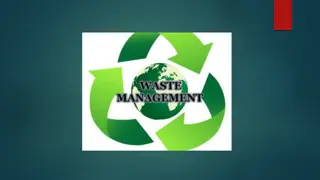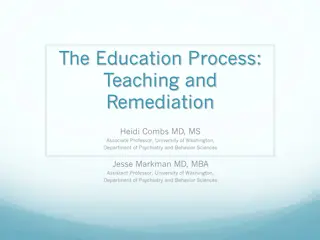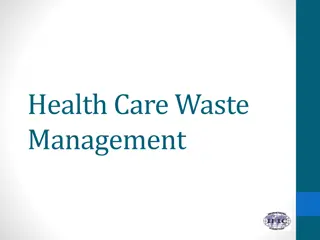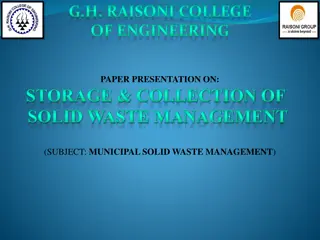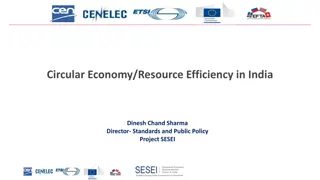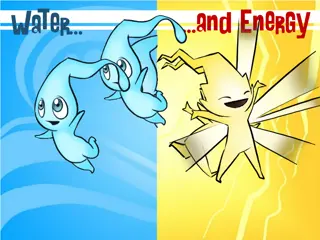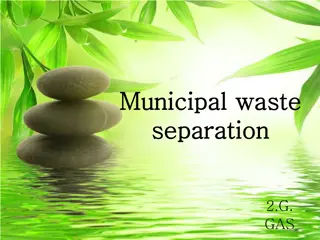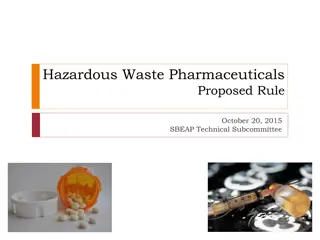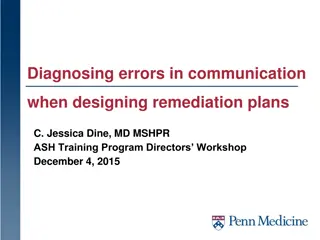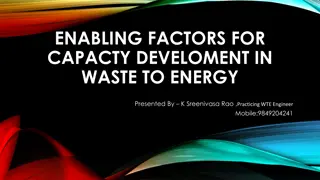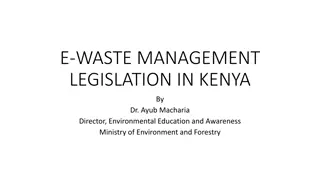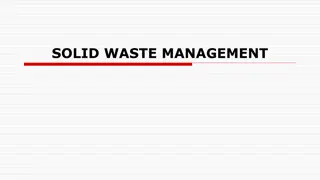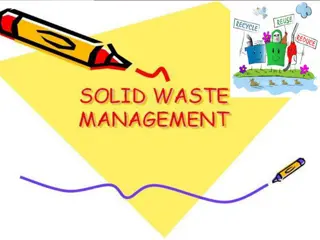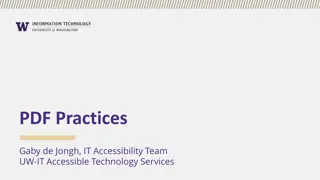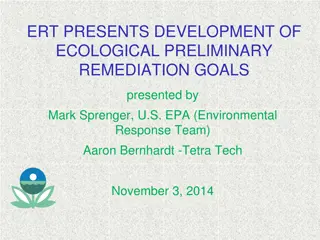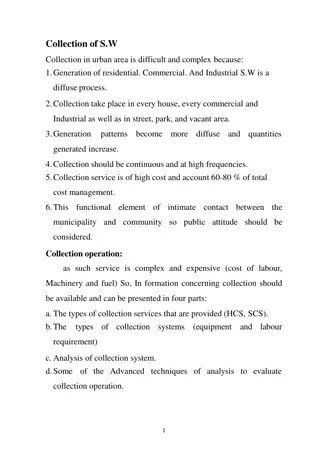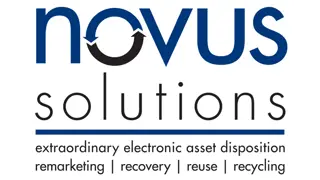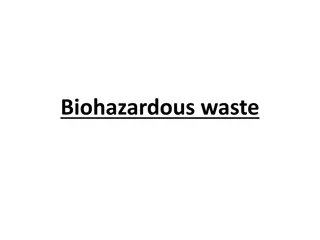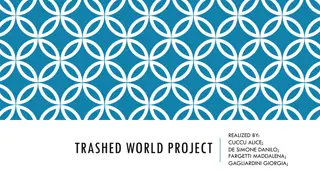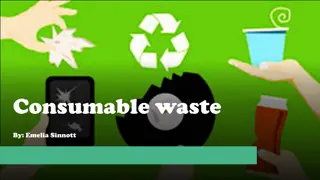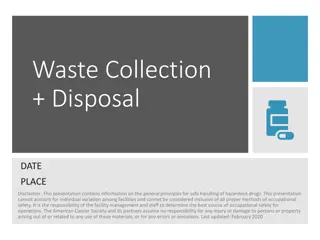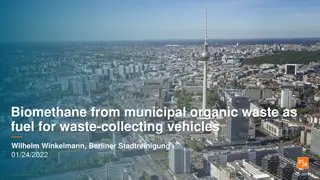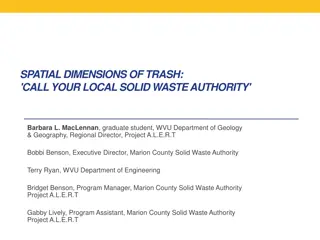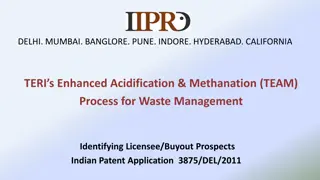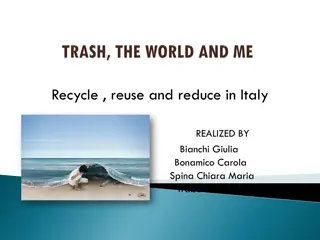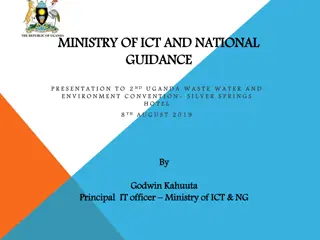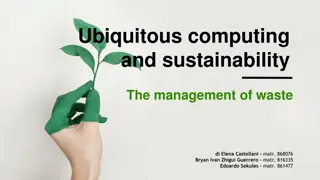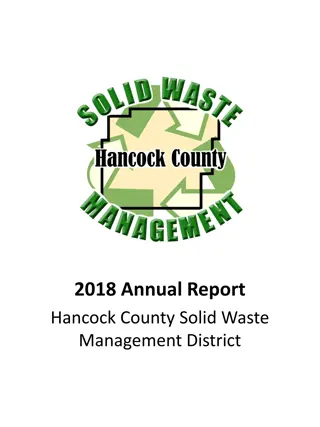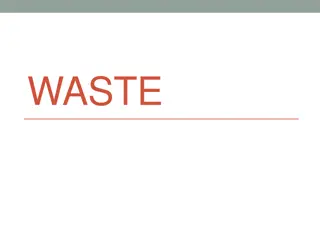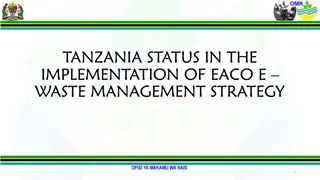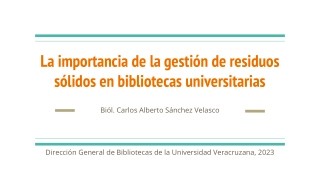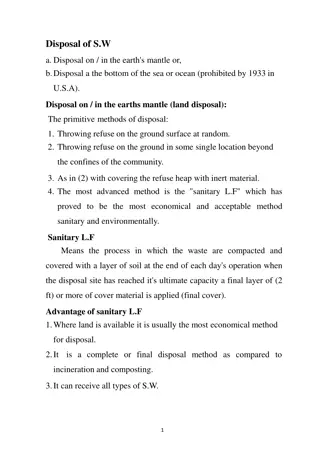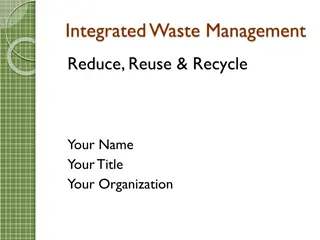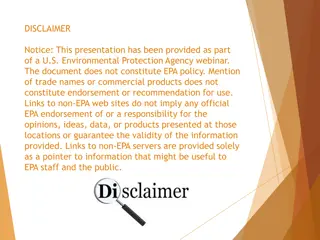Challenges and Solutions in Legacy Waste Management and Dumpsite Remediation in India
Legacy waste and dumpsites in India pose significant environmental and health hazards due to mismanagement over decades. The presentation highlights current status, composition of waste fractions, remediation approaches like bio-capping and biomining, challenges faced, and the role of initiatives like Swachh Bharat Mission 2.0 in achieving garbage-free cities. Legal mandates and the need for bio-remediation actions are emphasized to address the issue of over 3159 dumpsites covering 10,000 Ha in the country.
Download Presentation

Please find below an Image/Link to download the presentation.
The content on the website is provided AS IS for your information and personal use only. It may not be sold, licensed, or shared on other websites without obtaining consent from the author. Download presentation by click this link. If you encounter any issues during the download, it is possible that the publisher has removed the file from their server.
E N D
Presentation Transcript
1 Legacy Waste Management and Dumpsite remediation Azadi@75 Swachh Shehar Samvad & Tech Exhibition Dr. Richa Singh Municipal Solid Waste Programme Centre for Science & Environment 41, Tughlakabad Institutional Area New Delhi-110062, India
Content of Presentation Content of Presentation Current status of legacy waste dumpsites What is legacy waste? Composition and percentage of waste fractions Approaches to dumpsite remediation- Bio-capping and biomining Steps in biomining and key considerations Challenges and way forward 2
Swachh Bharat Mission 2.0 and Dumpsite remediation SBM 2.0 aims to achieve the vision of Garbage Free Cities over the next five years 31st March, 2023 for ULBs < 10 lakhs population 31st March 2024 for ULBs > 10 lakhs population Legal mandate Solid Waste Management Rules, 2016. investigate and analyse all old open dumpsites for their potential of biomining and bio-remediation and take necessary actions to bio-mine or bio-remediate the sites
Dumpsites in India Dumpsites in India current status current status 3159 dumpsites (according to Central Pollution Control Board) an offshoot of waste mismanagement for decades Covering an area of 10,000 Ha
Environmental and health hazards Environmental and health hazards due to Dumpsites due to Dumpsites Microbial degradation of wet waste causes GHG EMISSIONS Primary and secondary collection and transportation Mixed waste Biodegradable (wet waste) & non-biodegradable (dry waste)
Status of Status of dumpsites dumpsites in India in India 6 Source: CPCB annual report, 2019 20
What is legacy waste ? What is legacy waste ? Aged municipal solid waste Partly, completely, un- decomposed waste Contains scrap polymeric and combustible materials Inerts 7
Composition of legacy waste Composition of legacy waste Indian dumpsite contains a mix of legacy waste (aged waste) and fresh MSW. Characteristics and composition are different which affects the choice of treatment technology and end use of recovered material. Significant proportion of fine-soil like material (40 to 60 per cent) The combustible material ranges between 15 to 18 per cent on weight basis. Coarser particles such as broken bricks, masonry, stones etc constitute nearly 20 per cent. Other miscellaneous fractions comprising broken glass, metallic fractions such as razors, needles, sanitary waste, and diapers might constitute almost 1-5 per cent in the total waste quantum. 8
Available options for remediation Available options for remediation Biomining of dumpsite: entire waste is treated entire land is reclaimed entire waste fractions are used for gainful applications Bio-capping of dumpsite: Leachate collection and treatment Land is not recovered. Legacy waste is not treated, no waste fractions utilized Hybrid model (biomining and bio-capping) A fraction of waste is treated A fraction of land is reclaimed A fraction of waste are used for gainful applications Rest of the unused waste is bio-capped 9
Steps for biomining of legacy waste 1. Pre-feasibility assessment, including thorough site investigation studies, surveys and waste characterization; Systematic excavation of legacy waste; Stabilization by the spraying of bioculture to reduce the volume and mass of the waste; Processing of the excavated fraction; Utilization of extracted waste fractions in various gainful applications; and Clearing and conditioning of recovered land 2. 3. 4. 5. 6.
Pre-feasibility assessment Technical and operational feasibility Economic feasibility Legal feasibility Timeline feasibility
Requirements of the planning phase Alternative plan for treatment and scientific disposal of fresh waste conduct risk assessment and emergency planning Training and capacity building of the manpower involved Low-lying areas in the city and surrounding areas to be identified to ensure end-use of fine fractions; Tie-ups and collaborations with nearby cement plants Potential recyclers to be explored; Availability of sufficient water and power supply to be ascertained
Secure entrance gate Security and reception office Weighing bridge Records room Laboratory Medical room Workers area Parking for vehicles (heavy earth equipment, trucks, etc.) with tyre washing facility Administrative building Temporary storage area for rejects, domestic hazardous waste and sanitary waste Material storage area Environmental monitoring unit Leachate collection and treatment unit Fire control unit Waste drying and windrow area Toilet bath complex, with personnel protection equipment (PPE) storage room) Overhead water tank 14
Considerations during legacy waste excavation and material handling Preparation of a detailed operation plan Availability of PPE Provisions for fire control Depth of excavation Procurement of machinery and equipment Trained manpower Odour and dust management Record keeping Regular monitoring Environmental monitoring
Considerations during legacy waste processing and material handling Space for waste stabilization and processing Procurement of equipment/machineries for sorting and processing of legacy waste fractions; Quantities, types and variability of material to be handled; Number and types of vehicles or other transport means required for segregation, separation and dewatering; A record of quantity of waste treated and diverted should be prepared on a daily, weekly and monthly basis.
Utilization of extracted waste fractions for gainful application Following three factors are critical in assessing the potential of the scrap combustible fraction (SCF) used in cement plants: calorific value of the waste should be greater than or equal to 2,500 kCal/kg; ash content should be less than 20 per cent; and moisture content should be less than 30 per cent
Considerations for gainful application of recovered legacy waste: Fractions recovered from the mining of legacy waste should be tested, especially for the presence of toxic metals and organic contaminants.
The way forward Developing a sustainable fresh waste management plan Ensuring maximum utilization of recovered fractions Utilization of the reclaimed land Incentives for proper management of recovered materials Capacity building of ULBs, SPCBs and state urban development departments Construction and sustainable operation of sanitary landfills Download the report: https://www.cseindia.org/toolkit-legacy-waste-management-and- dumpsite-remediation-to-support-swachh-bharat-mission-2-0-11417
Lessons learnt Lessons learnt It is important that new legacy sites are not created; for this, the city waste management plan is critical focussing on: 1. 2. Source segregation 100 per cent waste processing and treatment Only rejects and inerts should be disposed of in sanitary landfill 3. 20
Thank you Let s build a zero landfill nation for our future Let s build a zero landfill nation for our future generations generations





